By: Ivey Schofield
The City of Whiteville just got a boost in its efforts to stimulate economic development downtown through a program that has invested billions of dollars across the state.
By: Ivey Schofield
The City of Whiteville just got a boost in its efforts to stimulate economic development downtown through a program that has invested billions of dollars across the state.
Editor’s note: This is the second of a three-part series that features the Lumber River. Part I covered ecotourism possibilities for Lumber River State Park and Fair Bluff. In this story, Publisher Les High talks with Fair Bluff residents who frequent the river.
For the people of Fair Bluff, love of the Lumber River comes naturally.
The Rev. Ray Lundy, pastor at Fair Bluff Baptist Church from 1979 to 2009, spent many an hour fishing, boating, and camping on the river with his wife, children, and grandchildren. He grew up fishing the Little Pee Dee and Waccamaw rivers with his father near their hometown of Conway, S.C.
“I was a river rat as a kid,” Lundy says. “My father went fishing every week when it was warm. He let me go with him, but only after I learned to swim. He always told me you have to respect the river.”
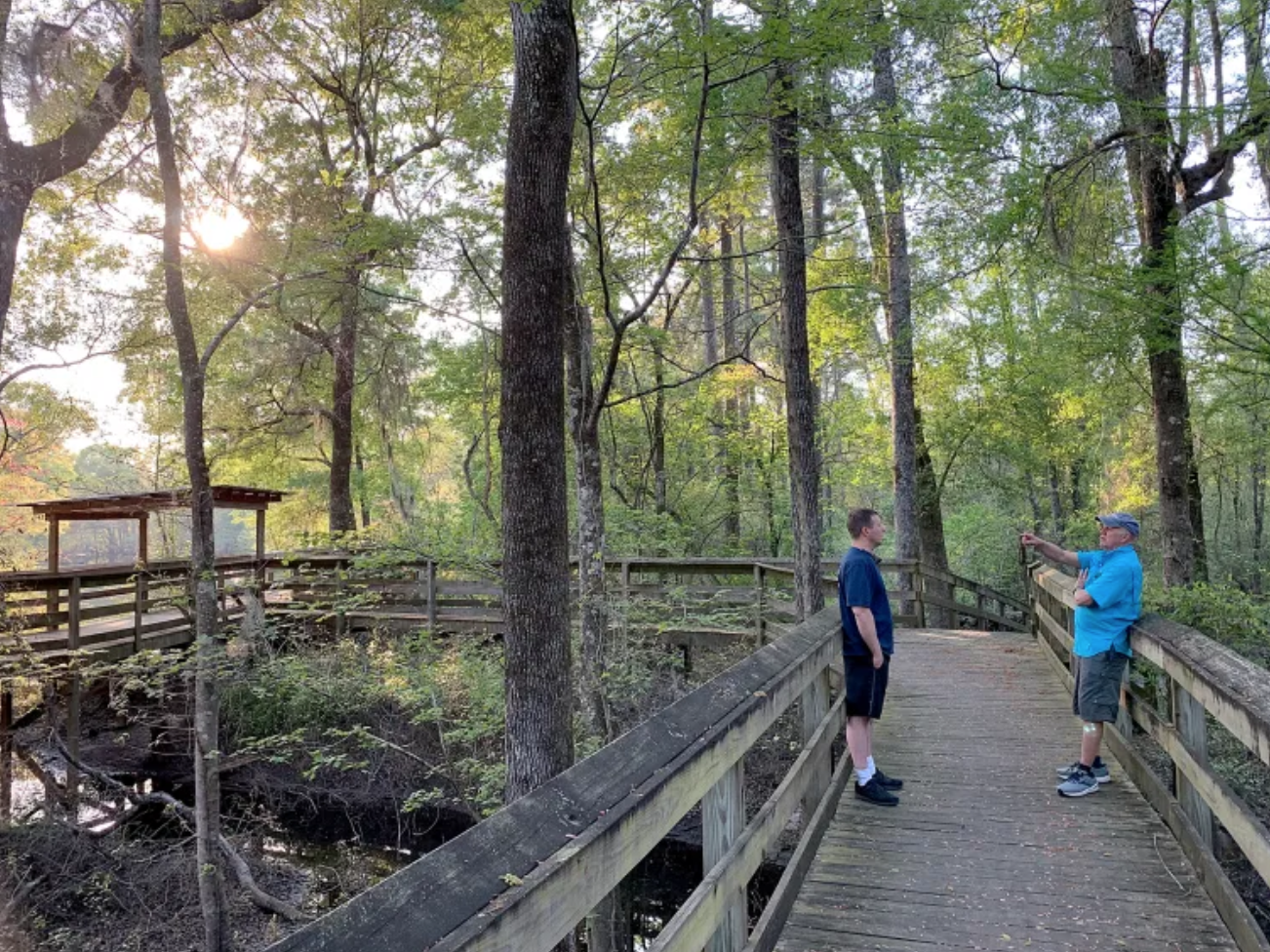
The Rev. Ray Lundy and Todd Bryant share a few moments on the Fair Bluff River Walk, which runs for nearly a mile along the Lumber River. All photos by Les Hig
The town embraced Lundy and his wife Linda when they arrived in Fair Bluff. That meant spending lots of time on the river with friends and parishioners.
He points in the direction of the rope swing and sandy bank where dozens of boys and girls swam in the dark waters. Locals still call it the “Minnie Hole,” named for Minnie Waddell, who fished there often.
Lundy remembers building fires on cold days with his son Jonathan, cleaning ducks in the frigid water. The family often had picnics along the river, and he and Jonathan would take three- to four-day overnight trips, putting up on sandbars to spend the night.
“I remember one day when it was hotter than the hinges of the door on the gates of hell,” Lundy says. “Jonathan told me there was a bad thunderstorm coming, so we hunkered down and it rained like you were pouring water out of a bucket. When it passed through, it was like someone had turned on the air conditioning; it was nice and cool.”
Lundy says he awoke sometime early in the morning to the smell of a wet deer, then heard the unmistakable snort of a bear. A dank, musky odor indicated the bear was close by, probably on the trail of the deer.
When Lundy opened the tent, the bear was nowhere to be seen. He tells the story because it underscores that when it comes to the Lumber River, the wilderness is “right out your back door.”

Lundy says the River Walk and the river offer the kind of peace that’s hard to find in other places.
Time on the river is second nature to people in and around Fair Bluff.
“I think some people are born with it, that wanderlust where you don’t know what’s around the next bend in the river,” Lundy says. “It’s something that’s innate in all of us, and I kinda feel sorry for people who don’t ever get to experience it. I imagine the last thing I’ll have in my head when it’s time to go are the times I had on the river.”
Lundy is naturally affable and gregarious. He enjoys chatting with people on the Fair Bluff River Walk, which meanders for three-quarters of a mile through the cool canopy of cypress and water oaks. He and Linda are on the boardwalk many days, she on foot and he on his recumbent tricycle.
They meet people from all over the East Coast, but locals especially enjoy the meditative powers of the slow-moving water.
Todd Bryant, who lives just across the border in South Carolina, is taking a stroll on the boardwalk on a perfect, sun-drenched late afternoon. Bryant and Lundy begin talking about fishing holes and a three-story tree house that men who fish and hunt on the river assembled in stages over the years.
Lundy shows Bryant the old steam engine rail bed that runs through Red Belly Slough. The tram transported logs from Butters Lumber Company in Boardman to Nichols, S.C., about 30 miles downstream. The old trestle supports barely show above the water.

Luke Robinson with his dog Cooper.
Also on the River Walk, Luke Robinson has taken his dog Cooper, age 9 months, for a walk and a swim. The dog clearly has great affection for Robinson, who says he got Cooper from someone who was going to “throw out the rest of the litter,” presumably by the roadside.
“I’m going to get some ice cream and give Cooper a treat,” he says before disappearing into the fading light around one of the many bends of the boardwalk.
•••
Few people have caught more fish on the lower end of the Lumber River than Willard Small, who turned 96 on April 19. He was a Fair Bluff town commissioner for 48 years and co-owner of Fair Bluff Ford, the local Ford dealership.
“People don’t realize what a good fishing river this is,” Small says. “We’d lock the dealership on Saturdays at 1 p.m. I’d get in my Ford Bronco and head to the river with my strip boat and fish ‘til dark.”
Small would mainly fish for red breast and hard head bream, which are varieties of flatfish.
Small closed the dealership every Fourth of July and a group of men would paddle upriver to wet a line and fry fish on a sandbar. This went on for 20 years or so.
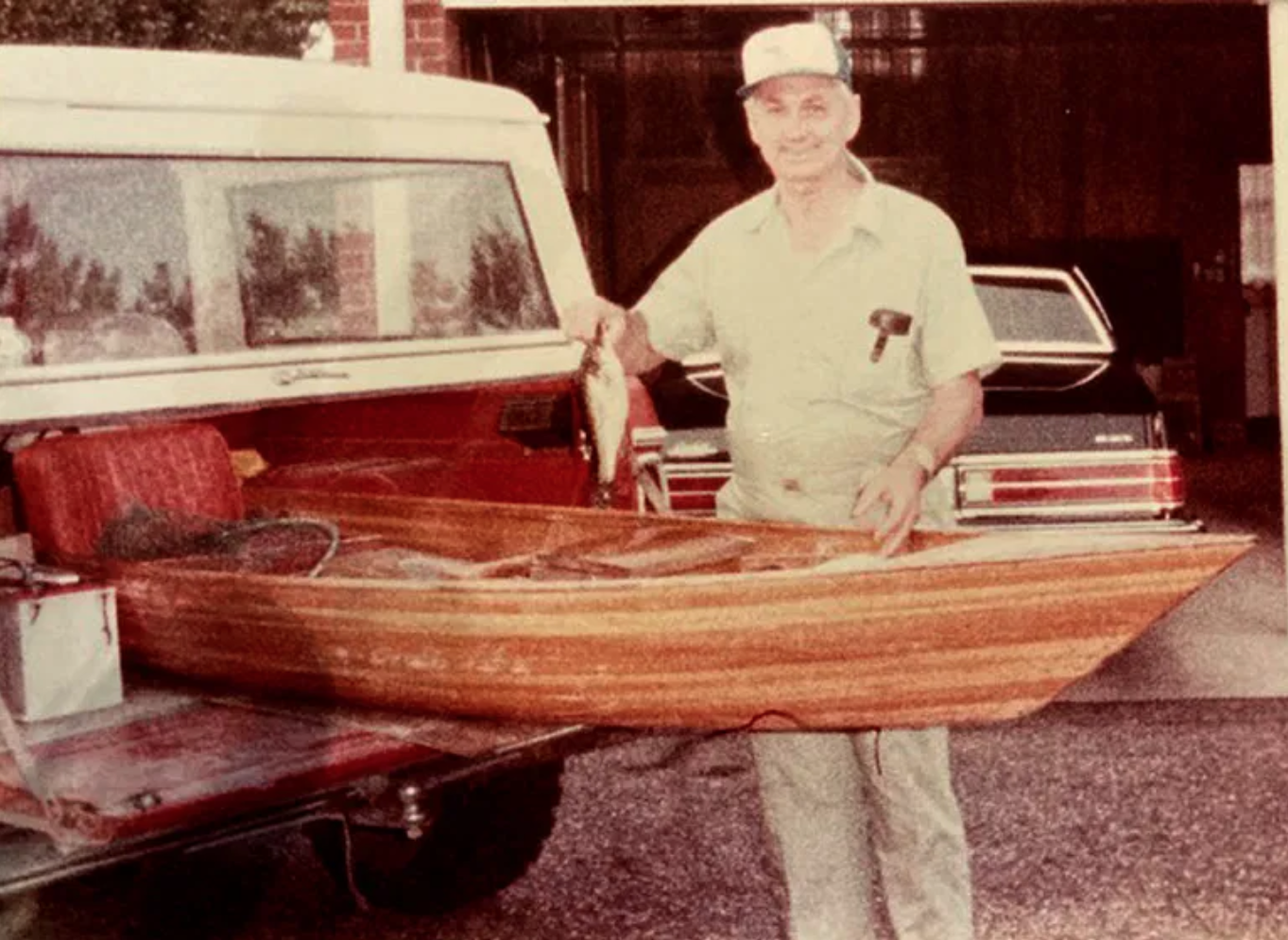
Willard Small, 96, is a life-long fisher of the river who was instrumental in getting the Fair Bluff River Walk funded. Contributed photo
David Small, Willard’s 74-year-old son who worked at the family dealership, says fishing is a way of life on the river, going back generations.
Small recalls the bond fishing created between him and his grandfather Maxcey Small. The younger Small was his grandfather’s designated paddler, “and I inherited my love of the river from him.
“He’d pull up to the house before daylight – around 5:30 – and blow the horn,” Small says. “Nothing interfered with his fishing. He’d even leave the tobacco field if he heard the fish were biting.”
Small says his grandfather knew all the fishing holes and lakes along the river: State Line Lake, Grassy Lake, Deep Lake, Big Hog and Little Hog lakes, among others.
Small’s main task was to paddle, though he occasionally got to fish when the two took a lunch break on a sandbar. That led to a lifetime of fishing with his grandfather and father, and later on his own.
He remembers as a child an area behind Fair Bluff’s business district where the merchants kept about a dozen wooden boats tied up and ready to deploy should word get out that the fish were biting.
“The river and Fair Bluff, they’re one and the same,” Small says.
•••
It seems that everyone who fishes the river has had a traumatic experience with a thunderstorm.
Willard Small was fishing upriver at Deep Lake and heard thunder in the distance. Before he could make it home, it rained and hailed like he’d never seen.
“I had to stop three or four times to empty water out of the boat,” he said. “I’m telling you, I thought I wasn’t going to make it home.
“But, he adds, “one of the best times to catch fish is before and after a storm.”

The leaves of a low-hanging tree in the early-morning light.
As violent as the weather can be, however, Small sees the river and his beloved Fair Bluff River Walk as a place of calm and serenity.
Many locals enjoy the boardwalk daily, and Small was no exception in his younger years. It’s especially pleasant in the early morning or late in the afternoon, when the water meanders among the pilings. Birds, turkey, otter, deer, and other animals are common sights. It’s a good place to commune with nature.
“If you’ve had a bad day at work or just need some time alone,” Small says, “ the boardwalk is where you can be alone with your thoughts or just talk to the Lord.”
•••
One of the most prolific fishermen on the Lumber River is Michael Gore, 67, of Fair Bluff.
Most days he can be seen pedaling his bicycle to the Fair Bluff River Walk with a fishing rod and two buckets, one that contains dirt and earthworms and the other to hold the fish he’ll catch. He likes to throw a Beetle Spin lure because it attracts every kind of fish and “it saves you from buying worms.”
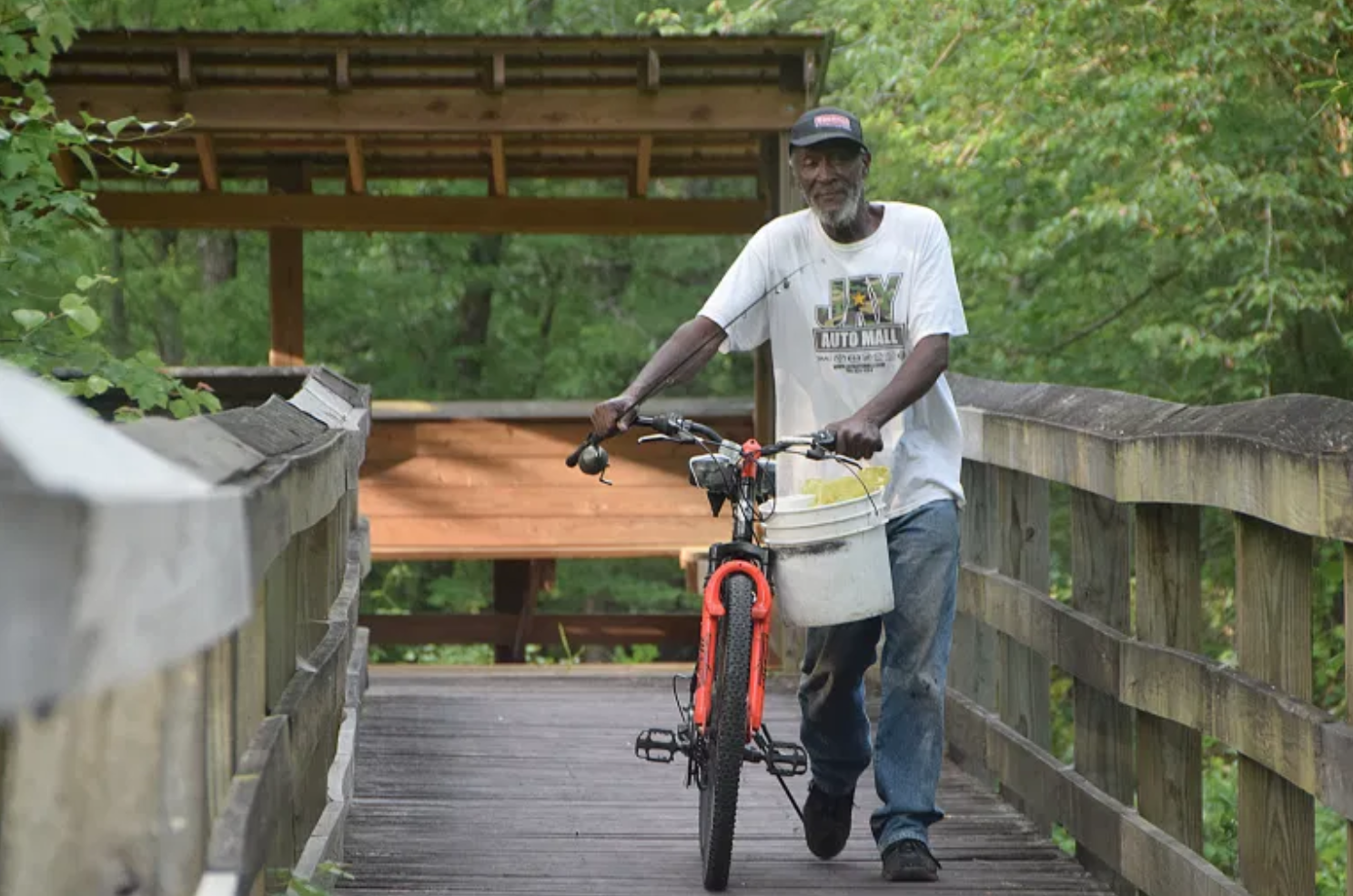
Michael Gore pushes his bicycle toward home after a successful day fishing on Red Belly Slough.
Gore chooses to fish by foot along Red Belly Slough or The Boon, both of which run close by the boardwalk.
Gore is one of 12 children reared by Mildred and Booker T. Gore. “I’m the only one who likes to fish,” he says with incredulity.
He has taught his five nephews to fish and to swim.
His cousin, Cubby Gore, described by Michael as in his 80s, was supposed to be with him on this temperate May afternoon, but Cubby has chosen to fish closer to the N.C. 904 bridge.
“One thing about Cubby,” Gore says matter of factly, “he does not like a snake.”
There happens to be one — a rather large water snake — resting on the edge of the river in a fallen tree branch.
Gore enjoys the River Walk in part because he was one of “nine or 10 guys” who helped build it. He remembers dragging timbers behind a riding lawn mower to the final section ending near The Boon.
Gore fishes “near about every day.” He’ll eat fish two to three times a week. “I was eating them every day at one time, but I had to stop.”
He mostly does odd jobs around town for money. His house flooded during hurricanes Matthew and Florence, but he never thought about leaving.
“Fair Bluff is one fine place,” he adds.
Earlier on this day, he had caught 10 fish and took them to a local convenience store. He gave them to a man who is too elderly to fish.
He feels at home at Red Belly Slough, named after the type of bream that frequent the narrow cut-through.
He throws the fish he’s caught back into the water. “They’ll be here tomorrow. You got to keep some in here.”
Gore reflects on his years of fishing. Red Belly Slough is his second home.“It’s cool, it’s quiet, and nobody bothers you,” Gore says before he leaves. “It’s about the only place in Fair Bluff you can get some good, quiet peace…because people are afraid of the snakes,” he adds with a hearty laugh.
Then his tone changes.
“You know,” he says with a sense of reverence, “you really can’t beat this place.”

Gore heads home over the railroad tracks at Fair Bluff. Chances are he’ll be back tomorrow.
This is the first in a series of three stories about the lower section of the Lumber River and the revitalization of Fair Bluff. A future series will feature the upper Lumber River.
On any given weekend in the southern mountains of Virginia, hundreds – sometimes thousands – of cyclists pedal the 17 miles from near the peak of Mount Rogers to Damascus, Va. It’s almost all downhill as the 1,700-foot descent winds along an abandoned paved or hardened rail bed that’s transected by wooden bridges spanning Laurel Creek.
A second stretch runs from Damascus on mostly flat ground to Abington, Va., completing the 35-mile trail.
Damascus, once barely clinging to life after the closure of its main industry in 1986, now thrives as cyclists and hikers crowd restaurants and stores almost year-round.
Two hundred and eighty-nine miles to the southeast lies Fair Bluff in Columbus County. Ravaged by floodwaters from the Lumber River following hurricanes Matthew and Florence, downtown is devoid of the throngs of people who once filled the streets during tobacco market. The crumbling historic brick buildings sit empty. The town clock on Main Street no longer tells the time, stuck on 11:30.
It is a tale of two towns, one of opportunity fulfilled, the other still looking for a new identity.
Thirty-four years ago, people in and around Abington and Damascus and a U.S. congressman representing the district had a vision for a transformational project that would capitalize on the growing number of cyclists and ecotourists coming from the cities looking for adventure. The railroad abandoned the line in 1977. Congress later appropriated $2 million to turn the railbed into a greenway. The result was the Virginia Creeper Trail, which opened in 1989 and is now visited by approximately 250,000 people annually.
Fair Bluff finds itself at a crossroads similar to that faced by Damascus in the mid 80s, which begs the question: Can the river that devastated the town twice in three years transform itself into a destination that will draw paddlers and other ecotourists from far and wide?
•••
Though it’s unlikely that hundreds of paddlers would take to the river on any given day, the pieces are in place to make Fair Bluff an ecotourism destination.
Lumber River State Park Superintendent Lane Garner believes the river and state park will grow as more people seek solace in the great outdoors.
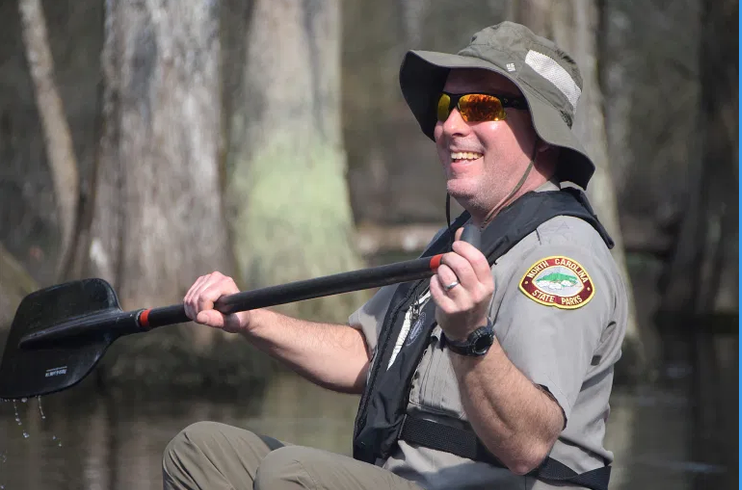
Lane Garner, superintendent of Lumber River State Park. Photo by Les High
“We like to say we are in the forever business,” Garner says, “meaning we manage properties that will be protected forever. I hope to see more property protected through various agencies and conservation groups like the Lumber River Conservancy or private citizens that realize the importance of being good stewards to the environment.
“I also hope to see more recreation opportunities offered at the park with additional trails, both hiking and equestrian, camping opportunities like primitive and paddle-to sites, and RV sites. Recent floods have changed some of our plans because a majority of our land is in the floodplain, but with careful planning I hope to see additional facilities that can withstand future storms.”
Garner believes that as use of the river increases, the state park and Fair Bluff have the opportunity to grow with it. He envisions everything from private outfitters to a brewery and bed and breakfasts in Fair Bluff.
River Bend Outfitters
Richard Willis and the late Stacy King once ran an outfitting service on the river, operating for nine years from a small building at the boat landing in Fair Bluff.
King had a vision to promote Fair Bluff and its natural resources, Willis said. One result of that vision was River Bend Outfitters, founded in 1997. King, in his 70s at the time, owned canoes, kayaks, and other equipment, had an amiable demeanor, and “sought the best in people,” Willis said.
Willis, the younger of the two and in his 30s, did most of the guiding and heavy lifting of canoes and kayaks. He was working at a job out of state and looking for a way to get back to his hometown.
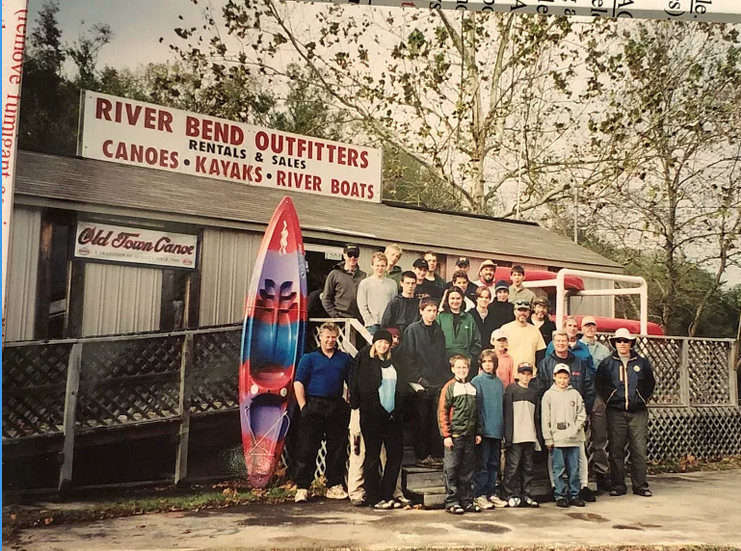
A group in front of River Bend Outfitters, which operated for nine years out of Fair Bluff by Stacy King and Richard Willis. Submitted photo by Richard Willis
Guiding people on the river was a natural fit for Willis.
“I loved the camaraderie and teaching people about the river and nature and all it has to offer,” he says.
River Bend had about 20 canoes and 20 kayaks. Most excursions were in the summer months.
“Some days we didn’t have enough canoes and kayaks and some days there would be a drought,” Willis says.
River Bend didn’t do many overnight trips because the Lumber River has little in the way of land adjacent to the water. Trips were mostly about four to six hours long, paddling from U.S. 74 to Fair Bluff, or three hours long, winding from Princess Ann to Fair Bluff.
Like everyone else who talks about the river, Willis notes that it can be dangerous, with varying degrees of water levels and velocity, snags or “strainers,” and sand bars. He generally required a guide for every seven boats.
There were the occasional incidents, including one couple who got into trouble and walked back to Fair Bluff after finding their way out of the swamp.
Willis believes another outfitter could make a go of it today. He says anyone getting into outfitting would probably need a supplemental income.
“It was mostly a weekend thing,” Willis says. “We had a lot of repeat customers. Now with all this traffic coming through town, who knows?”
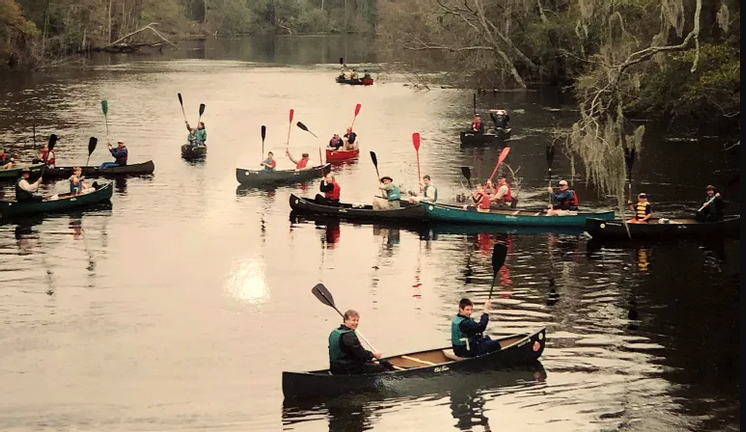
An early group in River Bend Outfitter canoes near the take-out point in Fair Bluff. Submitted photo by Richard Willis
The river has its pluses and minuses for outfitting. Its narrow width and sharp turns make it hazardous for canoes and kayaks to share the river with motor boats. There aren’t a lot of take-out spots for lunches unless the water is low and sandbars are exposed. He loathes the increased logging of old-growth trees that are felled to within only 50 feet of the river, leaving ugly scars that will last a generation.
“But,” Willis says, “guiding on the river brought a lot of joy and pleasure to me personally. It’s such a tranquil place.
“If we can keep it in pristine condition…,” he says, his voice trailing off. “People don’t realize just how precious the river is.”
Reimagining Fair Bluff
Town Manager Al Leonard has been instrumental in trying to rebuild Fair Bluff after the hurricanes.
“Every community has to find out what its niche is,” Leonard says. “Fair Bluff’s is the Lumber River. With the growth in Myrtle Beach and Brunswick County, we want to align ourselves with what’s coming.”
Riverside Drive, Leonard notes, is full of pickup trucks during the warm months without much marketing or promotion. “It’s a really good place to spend a Saturday or Sunday with friends or family.”
The Columbus County commissioners, including Commissioner Randy Britt of Fair Bluff, funded a short section of the Fair Bluff River Walk, a winding, elevated wooden walkway that is adjacent to the Lumber River. It could easily be southeast North Carolina’s most beautiful trail.

A proposed master plan for the new Fair Bluff park where downtown is currently sited.
Town Commissioner Willard Small and Leonard were members of the state’s Tobacco Trust Fund board and later secured a $450,000 grant to extend the boardwalk to three-quarters of a mile.
After repairing water and sewer infrastructure and moving the town hall and fire department to new facilities, Leonard and town commissioners began to work on Phase II of the recovery — aligning the economic future of Fair Bluff with the river.
A photograph taken after Hurricane Matthew shows a fiberglass ski boat navigating down Main Street with ease. The dirty water didn’t recede for days. Mold and mildew spread like wildfire inside businesses. The water eroded the old brick, rendering many buildings structurally unsound.
The future of the nearly bankrupt river town was, as Leonard once put it, “bleak.” Many residents left, shrinking the population from more than 900 to about 625.
But Fair Bluff has found a spark.
Trail Life Troop 1533 boys and leaders launch a canoe at Princess Ann landing. Photo by Les High
The River Walk remains. The town recently cut the ribbon on a new housing complex and received funding to build a new business district outside the flood zone.
Fair Bluff hopes to secure an N.C. Parks and Recreation Trust Fund matching grant that will create a park with campsites, a farmer’s market, open spaces with a pavilion, and recreational fields and courts, among other features where downtown now sits.
The trick, Leonard says, will be finding money to tear down the existing buildings to make way for a new Fair Bluff that would come to rely on the very waters that nearly destroyed it.
Small supports the plan to convert downtown Fair Bluff into a destination for people looking for the same sense of nature he’s enjoyed for his 96 years.
“The people here are friendly and the river is just beautiful,” he says. “I believe Fair Bluff will come back even better than before.”
An old school bus probably served as a fishing cabin back in the day. Photo by Les High
Economic development tool
Development can conflict with the environment, but the economic development directors in Columbus and Robeson counties, Gary Lanier and Channing Jones respectively, believe the river can spur green economic growth and jobs.
“The potential for ecotourism with the Lumber River is immeasurable,” Lanier said, noting that the Lumber has been designated one of North Carolina’s five “Wild and Scenic Rivers.”
“As an avid kayaker myself, I have spent many enjoyable hours on the Lumber River. There is a constant current in the river that allows you to sit back in your boat and just admire the wildlife while you drift down the river.”
Having more outfitters would be a benefit to ecotourism growth, Lanier says.
“For the less athletic among us, a touring pontoon boat would let a lot of tourists enjoy the river, especially those who may not be able to canoe or kayak. I would love to see anything that will enable more people to see what a wonderful natural asset we have.”
Lanier would like to see funding for a river tourism master plan in conjunction with the state park.
Jones said efforts to clear the river of debris have greatly increased the possibility of the Lumber River becoming a paddling destination.
“The ecotourism sector is something that really needs to be evaluated and looked at as a prospect,” Jones says. “It has the possibility of increasing dramatically because of the resources and funding that have come to the county to clean out the river. The accessibility of individuals who want to take scenic tours has tremendously changed. They have the ability to go in there and navigate the river in a way that hasn’t been done in years.”
‘Very high water quality,’ but for how long?
Though stained dark brown with tannins like most coastal rivers, the Lumber is remarkably clean, says Joseph White, a biology professor at the University of North Carolina-Pembroke.
White grew up near the Catawba River in the foothills of North Carolina.
“The Catawba and its tributaries are just as charming and beautiful as the Lumber, but very different,” White says. “Many of the Catawba’s tributaries start as rocky, fast-moving mountain streams surrounded by rhododendron and mountain laurel. The larger streams and rivers they merge to create are often disturbed by channelization, impoundments, development in the riparian zone, pollution, and the like.
High water covers the dock at the N.C. Wildlife Resources Commission landing in Fair Bluff. Even though the water is dark with tannins, the Lumber River is remarkably clean. Water quality will be a key for ecotourism in the future. Photo by Les High
“It’s pretty special to have a major river like the Lumber that, at least to the naked eye, is in pristine condition. The fact that there are no dams, limited development on the river, and that water quality remains high, even with all of the activity going on in the watershed and the recent storms, really speaks to the gem the Lumber really is. Then add to that the bald cypress and Spanish moss, the swamps and wetlands…it really is a captivating place.”
White cautions that local and state governments must be diligent about protecting the river and the areas that surround it.
“Counties and municipalities can benefit from developing parks and features like the Fair Bluff River Walk and incentivizing new businesses that will foster and benefit from ecotourism,” White says. “However, I would urge counties to limit disturbance in the river’s floodplain or adjacent terraces, and that these developments have as small a footprint as possible. Fragmentation of the forests along the river will reduce the benefits of preserving the river.”
The greatest threats to the Lumber are pollution and the degradation of its high water quality, White says.
“Being in a rural area that is heavily farmed and with significant livestock operations, pollution should be a significant concern. This is pollution that washes into the river from fields, yards, and parking lots during rain events. It also includes things like fertilizers and pesticides as well as oil and grease, sediment from erosion on the uplands, and bacteria from pet or livestock wastes. The higher the abundance and concentration of these pollutants…the more concerning this threat becomes.”
The partnership with the conservancy permits UNCP students and faculty the use of protected properties for academic and research purposes.
“I think about how much the residents of the area and those who grew up here love and care about the river,” White adds. “I have the privilege of working with a few Lumbee folks, and to hear about the importance of the river in their history and culture is really moving.”
Southeastern Community College has received three years of funding to hire an N.C. Career Coach to support manufacturing students. The coach will focus on recruitment, retention and completion for the Manufacturing Skills Pathway through Workforce Continuing Education and the Advanced Manufacturing Pathway through the Electrical and Mechatronics Engineering Technology curriculum programs.
The funding, which will extend from July 1, 2019 through June 30, 2022, totals $215,283 over the three-year period. The State Board of Community Colleges awarded $118,746 for this position with $96,537 in local funds from the Columbus County Commissioners and five local companies: Atlantic Packaging of Tabor City, Council Tool of Lake Waccamaw, Filtec Precise of Tabor City, Honeycutt Produce of Chadbourn and Top Tobacco of Lake Waccamaw.
“This is exciting news,” SCC President Tony Clarke said Tuesday. “It demonstrates what can be done when we partner with employers and our county government.”

Whiteville native Alex Munroe, owner of Cape Fear Vineyard and Winery, was named Business Person of the Year during the 21st annual Business Visions Award Banquet at UNC Pembroke.
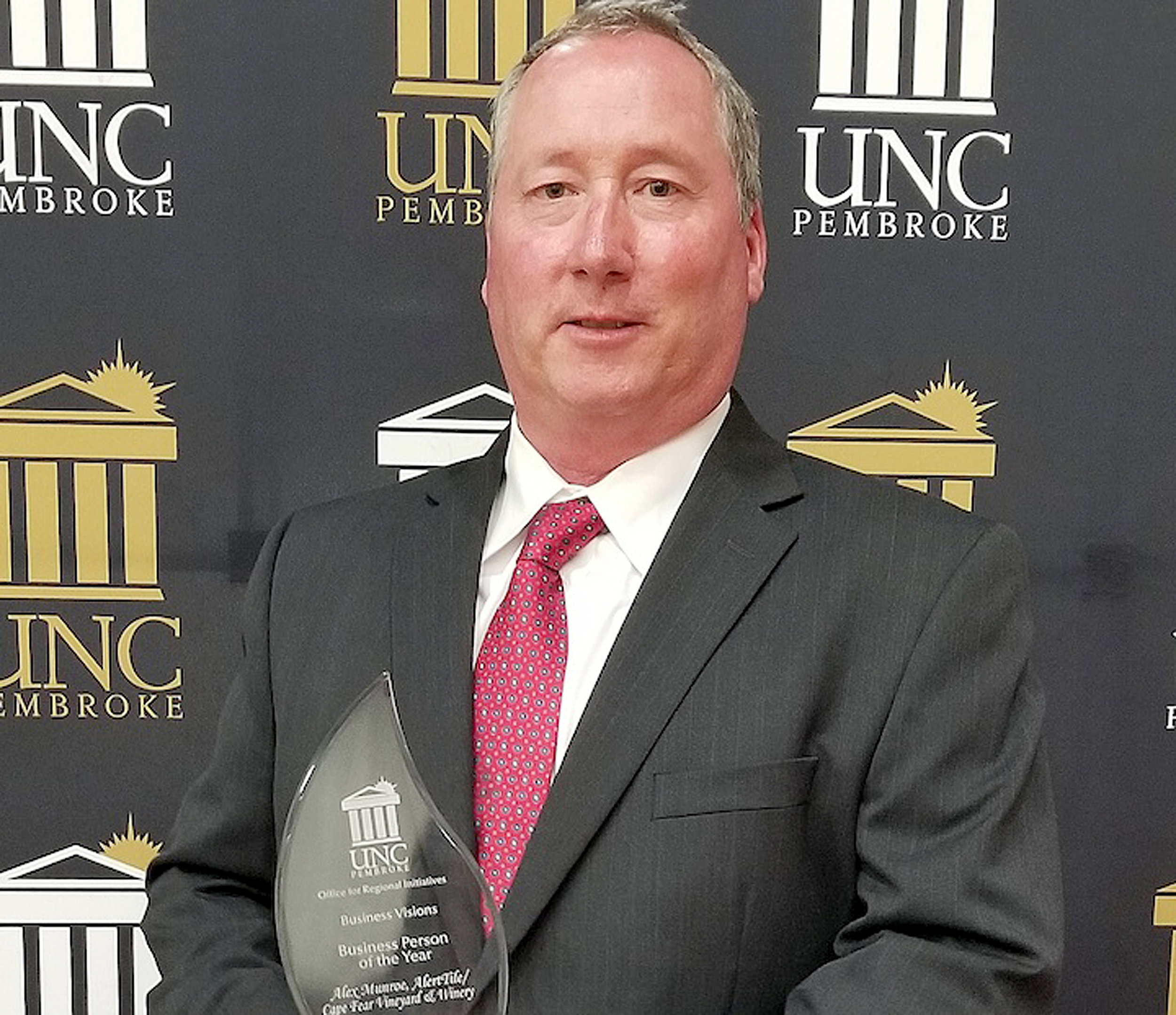
Alex Munroe
Each year, the Office for Regional Initiatives holds an awards program to recognize and promote success in the business community by recognizing students, entrepreneurs and business leaders.
Munroe opened Cape Fear Vineyard and Winery, spread over 13 acres in the Elizabethtown Industrial Park, in 2016. It offers both estate wines and other wines as well as a restaurant called The Cork Room. He also owns Cape Fear Systems, which supplies plastics for construction products.
He started his first company when he was 22. He owns 15 licensed patents for a variety of products, including Alertmat, a detectable warning mat designed to assist visually impaired people cross the street.
“In the dictionary beside the word entrepreneur there is a picture of Alex Munroe,” said Leon Martin, a UNCP Board of Visitors member.
“Alex is a unique individual. He started a new business in Bladen County that has been very successful and we are very proud of him.”
Munroe employs 40 people at his businesses in Elizabethtown.
“This is a great honor. I appreciate everyone here at UNCP, including Dr. [Barry] O’Brien and Chancellor Robin Cummings. It’s great that you guys have the Thomas Center for Entrepreneurship and the Business Incubator. It’s a great asset to the community,” Munroe said.
“I want to thank UNCP for this very nice recognition.”
Cape Fear Distillery
One of Munroe’s latest ventures is Cape Fear Distillery, which is located at Cape Fear Vineyard. The company recently sold the first legal bottle of alcohol that was distilled in the area. Cape Fear Distiller’s “Maritime Gin” is available for purchase at the distillery and will be available in ABC stores soon.
According to a new law, a state distiller can sell five bottles of its distilled spirits per person per year at the distillery site, provided that the purchaser takes a distillery tour. Tours at Cape Fear Distillery are $5 and include a free gin tasting.
“It literally took us six months to develop the recipe for our Maritime Gin,” Munroe said. “The retail space for distilled spirits is very competitive, so we took a methodical approach to the gin’s development and production. We literally hand craft each bottle yet we’re able to keep the retail price at $24.95, which is difficult in small batch production. The effort has been worth it, though, because we now have a terrific gin available at a great price.”
Rick Neisler of Lake Waccamaw is the head distiller.
“We wanted our first product to be special and conducive to the active lifestyle of southeastern North Carolina, so we developed a smooth, refreshing gin that’s great to sip beside the ocean or lake or enjoy in a cocktail on a boat,” Neisler said.

Cape Fear Distiller’s “Maritime Gin” is available for purchase at the distillery and will be available in ABC stores soon. Tours at Cape Fear Distillery are $5 and include a free gin tasting.

Two views of PreK-8 grade school to be built in Tabor City.
A $10.6 million state grant headed to the county schools will enhance new campuses planned for Cerro Gordo and Tabor City, the board of education has decided.
The Columbus County Board of Education voted Nov. 5 to use proceeds from the Needs-Based School Capital Grant, which was announced last month, to add more space for instruction to the new preK-8 schools they will soon build in Cerro Gordo and Tabor City. The funds can only be used for building purposes and not operating expenses.
Architect David Clinton of Szostak Design presented the board with redrawn plans showing four more classrooms at the Cerro Gordo campus and two more at Tabor City.
The state Department of Public Instruction mandates class sizes and specific room dimensions for the lowest grades. The first set of designs met that requirement, but in the expanded plans, “The rooms are now the recommended size rather than the minimum allowable size,” Clinton said. Science, career technology, art and music spaces will also increase.
There is “plenty of room for expansion,” Clinton said, by adding onto the ends of the buildings’ wings in the future.
The additional space, Clinton said, would answer concerns the board expressed earlier about room for expansion. “You’re looking at a hundred-year school,” he told the board. “It will outlast your grandchildren.”
Board members had been unenthusiastic about Clinton’s drawing of entrances on the previous plans but liked his new portico drawings, based on the columned entrance of the old Tabor City High School.
Instead of four columns at the front of each school, Clinton showed wider entryways with six columns each, which he said would better balance the width of the buildings. The columns will be molded out of low-maintenance fiber-reinforced polyester.
The new exterior drawings also showed contrasting brick accents that Clinton previously said he couldn’t afford to include.
Clinton added other “hundred-year, problem-free” materials to the new plan. The upgrades included standing seam “energy star” metal roofs, non-slip ceramic tile floors in bathrooms and locker rooms in place of sheet vinyl, terrazzo floors in reception/lobby areas and paperless gypsum board.
The board voted to allow Clinton to carry on based on the expanded plans. The board will take further action on plans at the December meeting.
The estimated costs for the two projects rose to $28,302,613.56 for Tabor City and $25,197,386.44 for Cerro Gordo, a total of $53,500,000.00 for the two.
The board authorized payment to Clinton’s firm for plans, to Soles and Walker for surveying services and to ECS Southeast for wetlands delineation.
Interim Superintendent Jonathan Williams called the $10.6 million state grant “a godsend” that will allow the schools to pay for “things we were leaving out” in the previous plans.
Whiteville City Schools was awarded a $4.3 million Needs-Based Public School Facilities Grant last month. The district intends to use the funds to help pay for a rebuild of the Whiteville High School campus.
dianamatthews@nrcolumbus.com
Southeastern Community College students will soon be able to co-enroll at UNC Pembroke, thanks to a new agreement SCC President Tony Clarke and UNCP Chancellor Robin Gary Cummings signed during a ceremony Nov. 5.
“I’m proud to collaborate with Tony as a partner,” Cummings said to a group of staff, supporters and students in SCC’s Cartrette Building. “In three or four years, every decent job” will require post-secondary training, he said. “And 80 percent of the jobs that will need to be done when today’s babies grow up do not exist now.”

Southeastern Community College President Anthony Clarke and UNC Pembroke Chancellor Robin Cummings.
That is why, Cummings said, UNCP cooperates with N.C. State University and East Carolina University to provide “Pathways to Success” in engineering and medicine.
Cummings said that applications for admission to UNCP had increased dramatically due to the N.C. Promise Tuition program, which cuts undergraduate tuition to $500 per semester for N.C. residents. “It’s like getting a $10,000 scholarship.”
The rest of the tuition cost is subsidized by the state. Students are still responsible for housing, food, books and other fees, he said.
“Pembroke is a school of access,” Cummings said. Now, in addition to making it easier for UNCP students to access graduate schools, he wants to make it easier for community college students to transition to bachelor’s degree programs at UNCP.
Under the new Bravestep program, SCC students can be simultaneously enrolled at UNCP. Their course work will transfer to the university. Students will have ID cards for both schools, allowing them to attend plays and concerts at Pembroke or use the athletic facilities and libraries they choose.
Some high school students aren’t ready for the university yet, or they’re still exploring their options, Cummings said. UNCP already has a similar pathway in place with Robeson Community College students.
“I’d like to thank Tony for reaching out to me and for always being a visionary. We have 90 students from SCC on our (UNCP) campus now, out of 7,000 — that’s over 1 percent — and I wouldn’t mind twice that many.”
Clarke followed Cummings at the podium and described the benefits of the new educational pathway.
High school graduates from within Columbus County who apply to SCC as their first choice and who meet academic and need qualifications can take advantage of the SCC Success Scholarship to reduce their tuition to zero for two years.
Now, with the seamless transfer to UNCP and the N.C. Promise Scholarship there, they will be able to attend two more years of college for only $500 per semester, saving $2,600 a year.
“You get your bachelor’s degree for $2,000,” instead of going into debt, Clarke said. “If you don’t have to borrow to go to college, you shouldn’t.”
Cummings expects UNCP applications to quadruple within the coming months. Although the university is committed to serving southeastern North Carolina students, “At some point we’ll have to cut off” accepting more for the 2019-2020 year. He urged students considering UNCP to send in applications as soon as possible.
Michael Ayers, the community college’s vice president of academic affairs, said he had been counseling a student about her post-SCC options that morning. “She said she was considering UNCP but wasn’t really sure. I told her, ‘Boy, have I got a deal for you!’”
By Diana Matthews
dianamatthews@nrcolumbus.com
The boards of both local school systems and Southeastern Community College want voters to know how funds raised from the proposed sales tax would be put to use.
The Southeastern Community College Board of Trustees unanimously passed a resolution Oct. 9 in favor of the sales tax increase. The resolution said in part:
“Whereas, if passed, Southeastern Community College will provide an annual report to the citizens of Columbus County how the monies are spent for capital outlay needs within the system;
“Now, therefore, be it resolved that the Board of Trustees of Southeastern Community College urges all registered voters of Columbus County, North Carolina to vote in favor of the Quarter-Penny Sales and Use Tax in the general election on Nov. 6, 2018.”
SCC President Tony Clarke said that the sales tax money will not take the place of funds already budgeted for facilities improvements at the community college but will supplement those funds, allowing greater improvements. He said four major areas where the funds will be immediately used are the welding program, improving library usage, updating science labs and expanding student services.
“We’re in a competitive environment in higher education,” Clarke said. Improving facilities, he said, will allow SCC to do a better job training workers in skills needed for business and industry. “It will help us contribute to economic development,” he said.
The community college will provide a report to the county each year detailing how the sales tax funds have been spent in pursuit of its stated goals.
“We will use the money for capital outlay — for buildings — only,” said Coleman Barbour, chairman of the Whiteville City Schools board. “We will take steps to let people see that we’re using the money appropriately, as we said we would and as the commissioners told us. We will not use the money for anything other than buildings.”
The Columbus County Board of Education passed a similar resolution Sept. 10, the same evening as the city school board.
County schools spokesman Kelly Jones said that, if the tax increase passes, “It means for the cost of 25 cents for every $100 spent, our school system will receive much-needed funds to make crucial repairs.
“We will give a detailed report at the end of each fiscal year describing the exact uses of the funds. This will be posted on our website no later than 30 days from the end of the fiscal year,” Jones said.
The transparency resolution was a proposal by the county commissioners.

U.S. Sen. Richard Burr, left, U.S. Labor Secretary Alexander Acosta, and U.S. Sen. Thom Tillis
U.S. Sen. Richard Burr, left, U.S. Labor Secretary Alexander Acosta, and U.S. Sen. Thom Tillis listen to county officials and Whiteville business people who were impacted by Hurricane Florence flooding Monday, October 15. The delegation included U.S. Rep. David Rouzer and toured Fair Bluff later in the afternoon.
BB&T announced Tuesday it will consolidate its Whiteville-area operations into a new $20 million facility that will be built at the intersection of J.K. Powell Blvd. and Columbus Street in Whiteville.
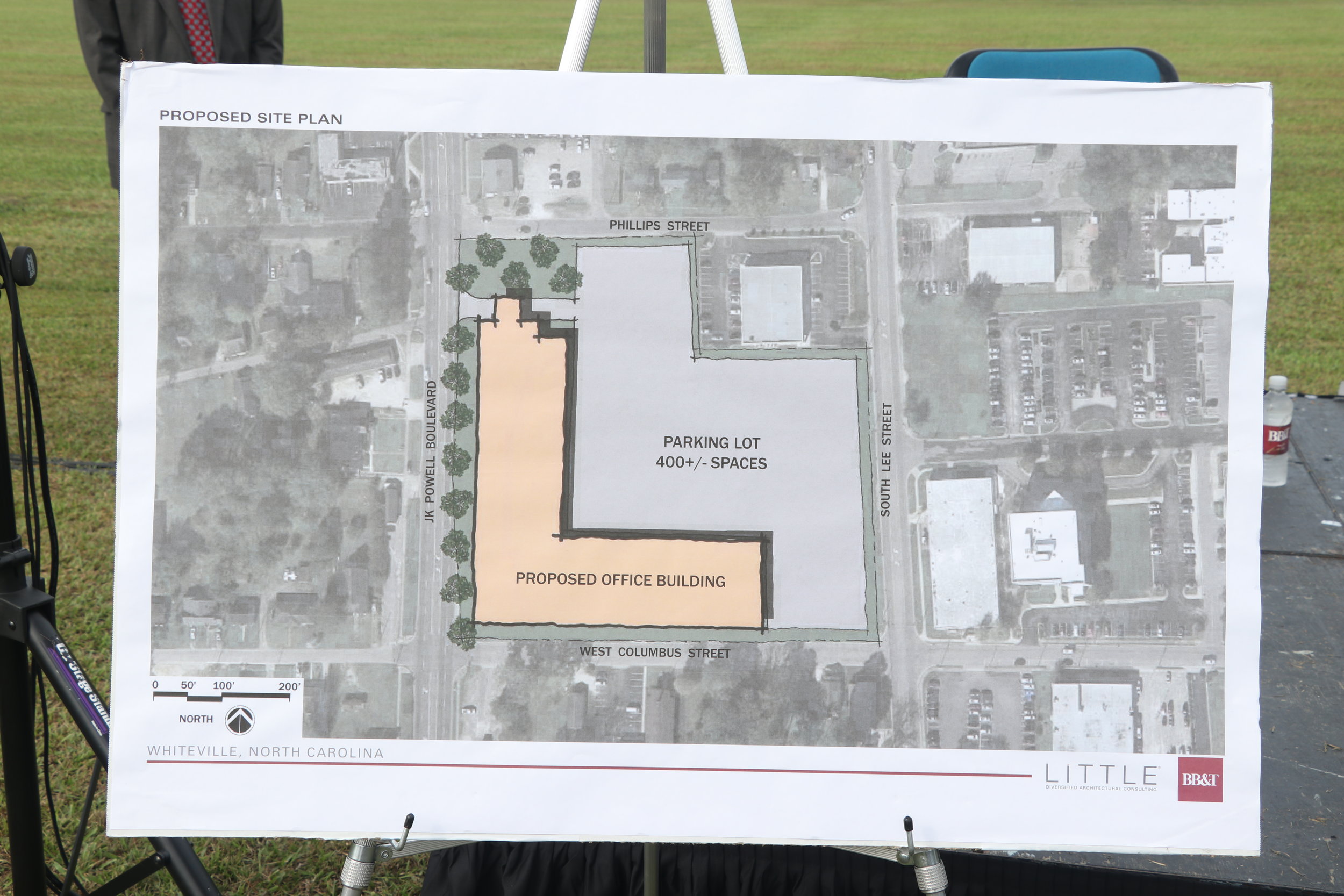
BB&T announced Tuesday it will consolidate its Whiteville-area operations into a new $20 million facility that will be built at the intersection of J.K. Powell Blvd. and Columbus Street in Whiteville.
The 100,000-square-foot building will house the 500 BB&T employees who currently work in nine locations in the Whiteville area, including its Client Care Center on U.S. 701 N.
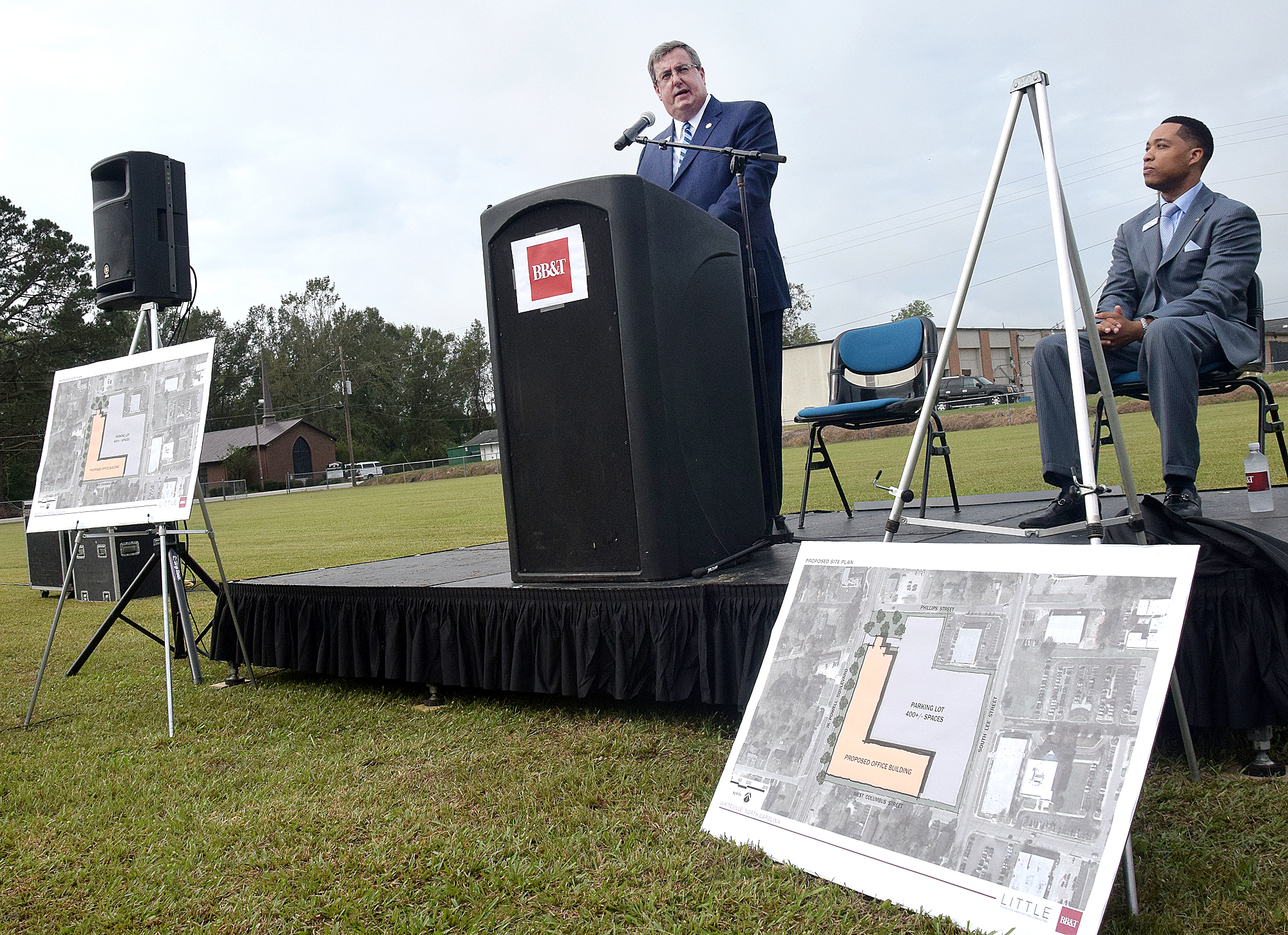
Phil Marion, BB&T southeastern Regional president, speaks at a press conference in Whiteville Tuesday. Staff photo by Les High
“We’re going to combine all of our facilities that we have here into this one amazing center, so our headquarters, our care centers will all come [together as] one family working here to serve our clients,” said Donta Wilson, BB&T chief client experience officer, at a press conference on the Kramer Soccer Field.
The soccer field, as well as an adjacent flea market and former bowling alley will be the site for the new L-shaped building, which will front J.K. Powell Blvd. and Columbus Street. The property is owned by Gary and Robin Kramer.
The bank expects to begin site work on the project during the first quarter of 2019 with an opening date yet to be determined.
“We made a commitment years ago that we wanted to make Whiteville a home for BB&T in a significant way, and we’ve done that,” said Phil Marion, BB&T southeastern Regional president. “And this [announcement] is very symbolic of that continued commitment. To me, this should be looked at as very positive news not only for Whiteville, but Columbus County, southeastern North Carolina and the state of North Carolina.”
Marion said decisions haven’t been finalized about the future of the bank’s current facilities in Whiteville.
“We will sort that out in the future,” he said when asked specifically about the multi-story glass headquarters on Columbus Street. “Today we don’t have plans for that, but we will continue to evaluate it and we’ll make that decision in due time.”
During the press conference, the bank presented a $1 million ceremonial check to Southeastern Community College President Tony Clarke and representatives from the community colleges in Bladen, Robeson and Sampson counties. The four colleges will share the funds to “train and prepare students to be workforce ready, potentially for BB&T’s Client Care Center, and other businesses requiring these skills,” a BB&T press release stated.
In an interview after the press conference, Marion suggested the training could help attract new employers that would utilize BB&T’s existing facilities.
“We’re trying to help these community colleges create a technology curriculum to help not only BB&T for its needs but other companies that would choose to relocate here,” he said. “These are magnificent facilities. You have BB&T, the eighth largest [bank] in America building a state-of-the art facility. You have city hall, who chose to go on the other side of our existing campus. So, I see a bright future for Whiteville and what we’re doing here.”
by Diana Matthews dianamatthews@nrcolumbus.com
Both local school systems will have millions of dollars in additional construction money, thanks to a Needs Based Grant from the state Department of Public Instruction.
The Columbus County School system has been awarded $10.6 million, and the Whiteville City Schools system has been awarded $4.3 million. State Superintendent Mark Johnson announced the grants this evening. Statewide, 13 school systems shared a total of $141 million this year. The funds are marked specifically for construction of school buildings in economically distressed areas. Last year’s Needs Based Grants totaled $30 million.

Rebecca Owens' kindergarten class enjoys a sunny day on the playground at Whiteville Primary School
“We are extremely grateful,” said Columbus County Schools Interim Superintendent Jonathan Williams. “We’re excited about the potential things this grant will enable us to do.
“With the money we (already) have to plan new construction, things were tight,” Williams said. The schools will continue to make frugal decisions so that “this money is going to go a long way,” he said, but “it will enable us to do things we want to do.”
Whiteville City Schools superintendent Kenny Garland broke the news to principals and audience members attending the Whiteville Board of Education’s monthly meeting only about an hour after receiving confirmation of the award from Johnson. Of the 13 systems obtaining grant money, Garland said, Whiteville City Schools is the only city system.
The announcement came at the end of a presentation by architect Paul Boney and two of his associates at the LS3P firm, in which they outlined details and costs of the Whiteville High School construction project that is soon to be advertised for bidding.
Garland agreed with board members that it would be appropriate to send letters to the Department of Public Instruction and to the General Assembly, thanking them for the support. He also commented that $4.3 million will not cover the WHS project, and “we have needs at the other schools,” so he hoped voters would approve the quarter-cent sales tax increase on the Nov. 6 ballot for continued renovations and maintenance.
R.J. Corman Railroad will receive a $600,000 grant from the N.C. Department of Transportation (DOT) to re-establish rail service to the Southeast Regional Industrial Park between Whiteville and Chadbourn, including service to the former Georgia-Pacific plant site that is now owned by Corman.
Corman is one of 14 short line railroads in the state receiving a total of $7 million in matching grand funds as part of the DOT’s short line improvement program.
“We look forward to seeing the positive impact these grant funds have on North Carolina’s short line rail infrastructure, which plays a key role in our economy,” said Julie White, DOT deputy secretary for multimodal transportation. “These improvements not only spur economic development, but also enhance the safety and reliability of rail operations across the state.”
The short line improvement program supports short line rail infrastructure health and performance throughout the state and enables DOT to partner with short line rail companies on rail improvement projects. This partnership helps the short lines meet customer needs in an efficient and cost-effective manner while also preparing them for growing service demands and partnerships with potential customers, according to a DOT news release.
Following a recent decision by the Columbus County commissioners to split the operations of the Economic Development and Planning departments into two separate offices, newly-appointed County Planner Samantha Alsup is preparing to move sometime in the next two weeks from her current office in the county Administration Building on Washington Street to the Miller Building on Jefferson Street.
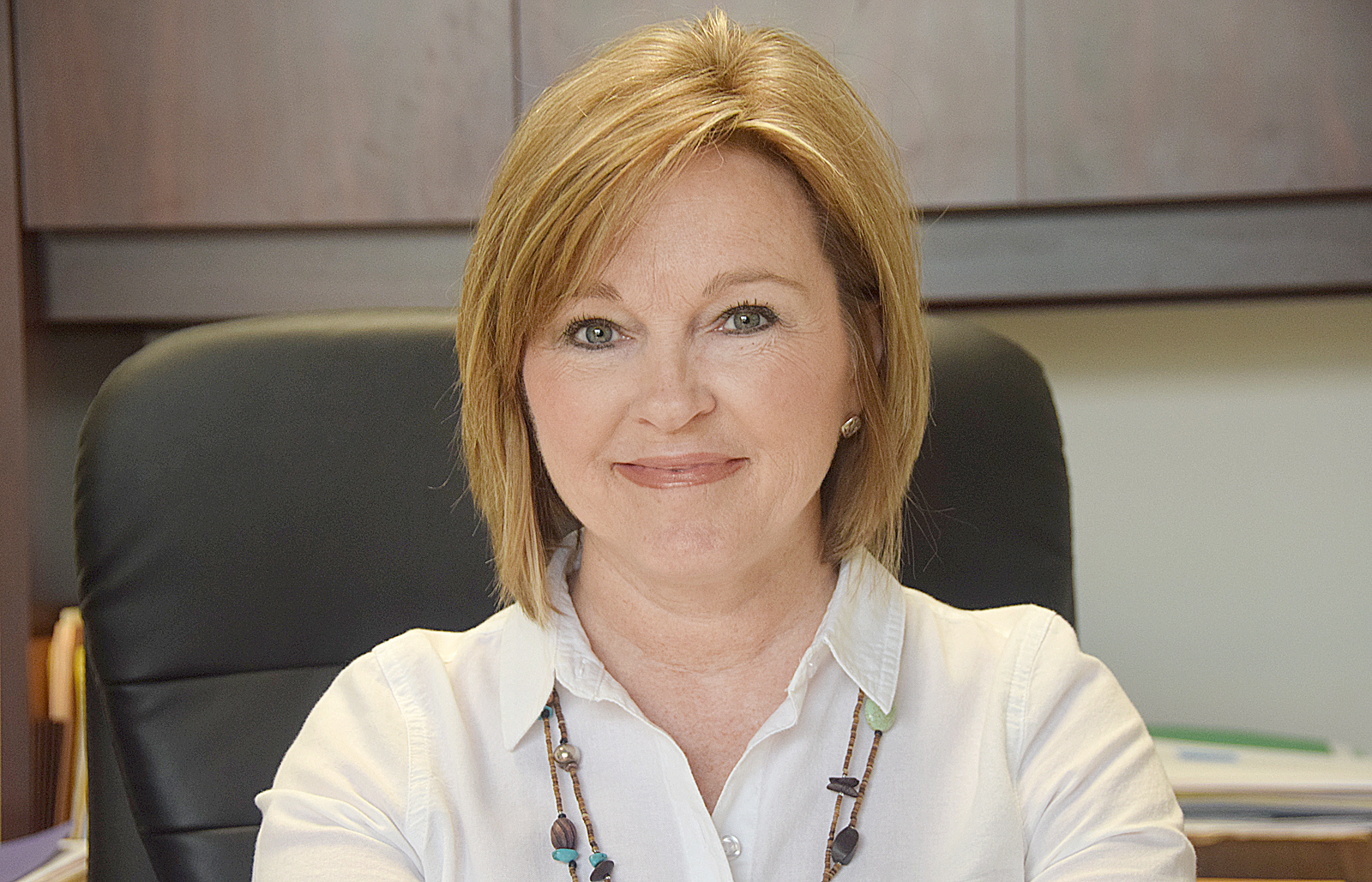
Samantha Alsup, Columbus County Planning Director
Commissioners decided to return to separate departments after implementation of the county’s zoning ordinance in 2014 made it apparent over time that planning operations had become much more technical and time-consuming.
Economic Developer Gary Lanier had agreed to take on the additional role of planning director several years ago, but the role has become more complex.
Also making sense to them was the appointment of Lanier’s administrative assistant, Alsup, as the new planning director. While most county and city planners in North Carolina hold degrees in planning, Alsup’s background as an attorney will aid her in implementing complex zoning regulations in the county.
“Planning is a very technical field. I am confident that, with her legal background, Samantha Alsup will do a great job as planning director,” said County Manager Mike Stephens.
Lanier, who will now focus exclusively on economic development, was equally supportive of the change. “Samantha has played a key role in handling a multitude of tasks related to the planning department since she joined the county staff almost four years ago,” Lanier said. “As a licensed attorney, she has the ability to interpret and apply planning and zoning statutes in support of our efforts to make Columbus County an even better place to live and work. Her experience and expertise have been, and will continue to be, invaluable.”
Lanier said Alsup’s contributions included helping county residents deal with FEMA following Hurricane Matthew, handing special use permit applications and complaints from citizens about abandoned structures and abandoned vehicles.
“She’s done all of this while supporting our economic development efforts and while getting the training needed from the School of Government to become a certified zoning officer,” Lanier said. “She is an outstanding asset to Columbus County in her new position and I wish her all the best as she takes on her new role as county planner.”
A native of Columbus County, Alsup grew up in Tabor City, the daughter of Vivian Orrell and the late Johnny B. Edwards. She and her husband, Keith, a banker, live at Lake Waccamaw with their two children.
After obtaining a bachelor’s degree in political science from UNC Chapel Hill, Alsup graduated from the Campbell University School of Law in 1991. She was employed by the local district attorney’s office for 18 years before opening a private legal practice, which she continued for three years before joining Lanier in the economic development/planning office.
She says she looks forward to working with the county planning board and county commissioners to create and fine-tune regulations for land uses within the county. She noted about 14 land uses are regulated by the county’s ordinance. Some have regulations required to obtain a special use permit, while others don’t.
“For example, when the zoning ordinance was passed we didn’t have any regulations for solar farms, but now we have such regulations,” she said. “Right now we don’t have anything in place for electronic gaming regulations and we need to do that. Electronic gaming is in legal limbo right now, but if the appellate courts eventually say such operations are legal, we have to be ready with regulations on that issue.”
Zoning issues and changes can be technical and cumbersome, with public hearings required before the planning board and, at times before the quasi-judicial board of adjustments, as well as before the county commissioners. With each proceeding, proper legal advertising has to be placed, adjoining property owners have to be notified and input taken from the public. In many instances, education of citizens who might be affected by zoning decisions also is part of the job.
Alsup believes that with her legal background, combined with specialized training in flood plain management (for which she’s also the county director), zoning, planning regulation and zoning certification from the School of Government at UNC-Chapel Hill, she is qualified for the challenges that lie ahead as the planning department enters its new phase.
Exactly when her office will move from the county Administration Building on Washington Street to the former offices of the Guardian Ad Litem program in the Miller Building on Jefferson Street is still undetermined, but it is expected to take place within the next two weeks.
The 10th Annual Take the Lake brought 577 participants to Lake Waccamaw this hot Labor Day weekend.

Bicycle events included the 16 mile personal endurance challenge around Lake Waccamaw and the 10K Family Bike.
An estimated 200 people took to the roads and trails Saturday morning during the Walk/Run. Events began and ended at Elizabeth Brinkley Park on the north side of the lake.
A 16-mile circular route challenged some of the runners and walkers, while the family walk and run followed a 10-kilometer (6.5-mile) course from the park to the boat landing near the state park entrance and back.
It was the first time participants were able to cross over dry-shod from the state park’s Lake Shore Trail to Waccamaw Shores Rd. with the help of the new pedestrian bridge near the Lake Waccamaw dam.
The Sunday 14-mile paddle started at Dales Seafood at 8 a.m. with 35 participants. The 16-mile cycle and the 6.5 family bike ride followed in the afternoon.
The Swim began this morning with 14 participants. TTL X-Treme Challenge was still underway at midday with two four-man teams and two individuals competing. The X-Treme Challenge is the only competitive portion of the weekend and combines all four endurance challenges in one intense day.

Over 150 walk/run participants completed the Lake Waccamaw State Park section of the 16-mile route over the new pedestrian bridge at the dam.

35 paddlers including several stand-up paddleboarders made the 15-mile round trip around Lake Waccamaw.
The former automobile dealership property in Fair Bluff that will be transformed into a wildlife sanctuary for big cats has officially changed hands and work is expected to begin soon on the site.
A deed giving Shizzy’s Wildcat Rescue ownership of the former Fair Bluff Motors property was recorded earlier this month to give the nonprofit title to 56 acres. The land was donated by Capital Investments, whose principals are Willard Small, Carl Meares Jr. and David Small.
Shazir “Shizzy” Haque said that one of his longtime supporters, Alisha Brazeau, flew in from Canada for the closing of the real estate transaction. “Our goal is to get to opening day within two years,” Haque said, calling the projected timeframe very realistic.
Haque had high praise for Columbus County Economic Developer Gary Lanier, as well as for Rick Edwards and Les High of the Columbus Jobs Foundation for helping navigate the nonprofit through zoning and ordinance changes in Fair Bluff that had to occur before plans could start being put into action.
He said that the rescue intends to use local companies whenever possible to help stimulate economic growth.
The facility, which will employ 7-10 workers, including two veterinarians, and utilize dozens of volunteers, will house big cats, such as lions, tigers and bears, as well as smaller species of wild cats and some birds.
The sanctuary cleared its last zoning hurdle in Fair Bluff in July after the town’s planning board approved the site plan.
Construction will be in phases, each of which will require additional approval from the planning board. Phase 1 will include completion of separate habitats for big cats and smaller cats, completion of a food preparation area and development of parking and animal loading/unloading areas. Phase 2 will include additional big and lesser cat areas and the bird aviary along with a walking path.
The big cat habitats will be surrounded by 16’ high fences, while the habitats for smaller cats will be 10’ high. The bird aviary, which will include a dome-shaped roof, will feature a 15’ fence. In addition, the perimeter of the entire property will be surrounded a 10’ fence. Video cameras and drones will provide surveillance to protect both the community and the animals. The site will have two electrical generators in the event of power failures.
Ever since the concept of the sanctuary first rose, officials of the Fair Bluff government, the Columbus County Economic Development office and the Columbus Jobs Foundation have been hopeful it will be will be a launching point in revitalizing the town after devastation nearly two years ago from flooding associated with Hurricane Matthew.
“If we get people to come here, then they will want to spend money on other things as well,” Haque told the planning board in July.
Safety will be a major priority in both the development and operation of the facility, Haque said. He has worked with two other similar facilities in his planning, neither of which has had an animal escape. He modeled his plans after their sites. He pledged to maintain close communications with the Fair Bluff Police Department and other public safety officials when the facility opens.
In another development related to the property transfer, Fair Bluff Auto relocated last week from the former Ford dealership property that will house the sanctuary to 1080 Main Street, the Scott Properties property formerly known as the Scotsman.
“We all knew this day was coming and our new location is ideal,” Fair Bluff Auto owner Jeff Prince said. “I was determined to keep my business operation in Fair Bluff, and this location gives us more flexibility with a comfortable lobby area, more office space and much better exposure, as we are now in the path of downtown traffic.”